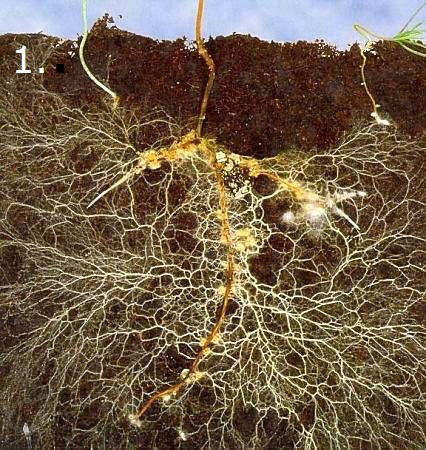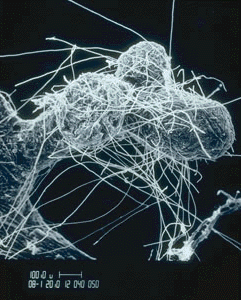INTRODUCTION
 Mycorrhizae
are fungi (mold) which grow very close to the roots of plants. They allow plants
to better take in nutrients and in turn receive nutrients from the plants such
as carbon and carbohydrates, so the relationship between the mycorrhizae and the
plants is helpful both ways.
Mycorrhizae work in two
different ways: if they can enter the cells of a plant's root, they are called
endomycorrhizal fungi, but if they cannot and are found outside of those cells,
they are called ectomycorrhizal fungi. Both
help the plant to attain more nutrients because they have hyphae, which are
parts of the fungus which can reach out into the soil. These hyphae are very
thin and allow the plant to reach farther into the soil than their roots can on
their own; therefore, the plant receives more essential nutrients.
Mycorrhizae
are fungi (mold) which grow very close to the roots of plants. They allow plants
to better take in nutrients and in turn receive nutrients from the plants such
as carbon and carbohydrates, so the relationship between the mycorrhizae and the
plants is helpful both ways.
Mycorrhizae work in two
different ways: if they can enter the cells of a plant's root, they are called
endomycorrhizal fungi, but if they cannot and are found outside of those cells,
they are called ectomycorrhizal fungi. Both
help the plant to attain more nutrients because they have hyphae, which are
parts of the fungus which can reach out into the soil. These hyphae are very
thin and allow the plant to reach farther into the soil than their roots can on
their own; therefore, the plant receives more essential nutrients.
Magnesium is an essential nutrient for plants, as it is important in photosynthesis, and studies have suggested that magnesium is one of the nutrients provided by mycorrhizae for plants. Without magnesium, plants would not be able to photosynthesize well—chlorophyll, essential for photosynthesis, contains magnesium.
By taking a biota survey (a snapshot
of the soil’s fungi, bacteria, protozoa, pH, elements, etc.), we found that most
of the research sites had low levels of magnesium, while one site had a healthy
amount. We also found that two of the sites with low magnesium also had low
fungal densities, while the site with a healthy level of magnesium had a high
fungal density. The other site with a low amount of magnesium had a
 high fungal
density, but the yeast density was greater than the mold density. After seeing
this anomaly, we made a hypothesis. We hypothesized that as the density of
fungus in the soil increased, the amount of magnesium in the soil would also
increase due to the presence of mycorrhizae. However, since mycorrhizae are mold
and not yeast, we also hypothesized that as the yeast to mold ratio increased in
favor of yeast, the amount of magnesium in the soil would decrease due to the
absence of mycorrhizae.
high fungal
density, but the yeast density was greater than the mold density. After seeing
this anomaly, we made a hypothesis. We hypothesized that as the density of
fungus in the soil increased, the amount of magnesium in the soil would also
increase due to the presence of mycorrhizae. However, since mycorrhizae are mold
and not yeast, we also hypothesized that as the yeast to mold ratio increased in
favor of yeast, the amount of magnesium in the soil would decrease due to the
absence of mycorrhizae.
Anyone can perform an experiment like this. Mycorrhizae also provide many other nutrients for the plants (for example, phosphorus) and one can test for any of these.
This image courtesy of: http://www.cof.orst.edu/cof/teach/for442/cinfo/myco.gif
Image 1 courtesy of: http://www.ktsa.com/Mycorrhizae----what-is-it-/6505797?contentRating=1
Image 2 courtesy of: http://academic.reed.edu/biology/Nitrogen/images/part1/bigFL1.jpg
Background courtesy of: http://patterns.ava7.com